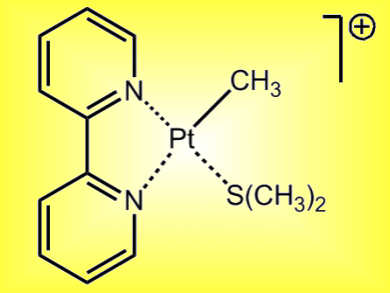2,2’-Bipyridine (bipy) ligands can achieve a “roll-over” cyclometalation with Pt. This involves rotation around the central C(2)–C(2’) bond and cleavage of the C(3)–H bond of a pyridine ring. For example, complex 1 is converted via methane loss to the “roll-over” cyclometalated species 2 (pictured).

Helmut Schwarz and co-workers, Technical University Berlin, Germany, have shown that mass spectra of such complexes in the gas phase contain a signal attributed to the loss of C2H4. This corresponds to dehydrosulfurization of (CH3)2S and an oxidative C–C coupling of the two methyl groups. By using isotope labeling studies, the team has shown that there is an exchange process between the methyl groups of (CH3)2S and the C(3)–H on bipy that precedes C2H4 loss. The heteroatom was shown to be crucial in driving the reaction as no C2H4 was observed when 2-phenylpyridine was used as a ligand.
These mechanistic insights may help to develop Pt as a potential catalyst for the dehydrosulfurization of sulfur-containing hydrocarbons.
- “Roll-over” Cyclometalation of 2,2′-Bipyridine Platinum(II) Complexes in the Gas Phase: A Combined Experimental and Computational Study
B. Butschke, M. Schlangen, D. Schröder, H. Schwarz,
Chem. Eur. J. 2008, 14(35), 11050–11060.
DOI: 10.1002/chem.200801658 - Presented at the Modeling of Molecular Properties Conference, Heidelberg, Germany, 9 October 2011.




